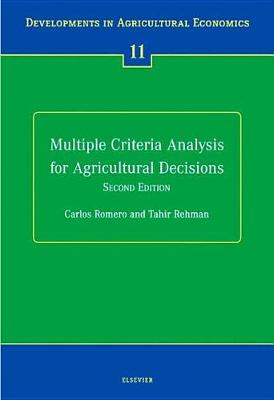Developments in Agricultural Economics
1 primary work • 2 total works
Book 11
Multiple Criteria Analysis for Agricultural Decisions, Second Edition
by C Romero and T. Rehman
Published 21 March 2003
This book presents the Multiple Criteria Decision Making (MCDM) paradigm for modelling agricultural decision-making in three parts. The first part, comprising two chapters, is philosophical in nature and deals with the concepts that define the underlying structure of the MCDM paradigm. The second part is the largest part consisting of five chapters, each of which presents the logic of a specific MCDM technique, and demonstrates how it can be used to model a particular decision problem. In the final part, some selected applications of the MCDM techniques to agricultural problems are presented and thus reinforce the development of an understanding of the MCDM paradigm.The book has been designed for use at different levels: as a textbook for final year undergraduate and postgraduate courses in modelling for decision-making; as a manual for researchers and practising modellers; and, as general reference on the application of MCDM techniques. Readers with basic appreciation of algebra and linear programming can easily follow the contents of this book.
Multiple Criteria Analysis for Agricultural Decisions
by Carlos A. Romero and T. Rehman
Published 1 May 1989
Despite the recognition given to the existence of multiple objectives in agricultural decision making, very little seems to have been done by agricultural economists to develop and use methodologies that model the decision situations realistically. This is particularly intriguing when one notices the amount of effort that has been devoted to the development and use of multi-criteria decision making (MCDM) techniques in disciplines such as management science, water resources research and forest planning. There are virtually no (text) books available in agricultural economics which explain the nature and structure of MCDM techniques and demonstrate how they can be used to model decisions involving multiple objectives. There is a need for such a book and this book attempts to fill the gap. It is divided into three parts. The first, comprising two chapters, is philosophical in nature and deals with the rationale behind the use of multiple criteria decision making (MCDM) techniques in decision making, and the fundamental concepts that must be understood to grasp the nature of these methods.

